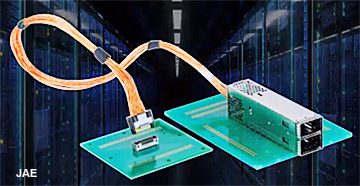DesignCon 2024 in Review
Connector suppliers shared new high-speed solutions for IoT, signal processing, electric vehicles, energy storage, machine learning and AI, photonics, 5G, and other technologies at DesignCon 2024.

Cloudy skies and drenching rain failed to dampen attendance and enthusiasm at this year’s edition of DesignCon, held in Santa Clara, California, January 28 to February 1. Broad topics included high-speed interconnect, chip packaging, Test & Measurement, PCB design tools and fabrication, as well as advanced electronic materials. in over 120 presentations, including keynotes, boot camps, tutorials, panel discussions, and technical sessions organized in 14 technical tracks. Seminars that addressed the many challenges of emerging 112 Gb/s and 224 Gb/s PAM4 copper channels were of particular interest. Recognizing the explosive growth of automotive electronics, DesignCon 2024 included Drive World, showcasing the latest innovations of automotive electronics and intelligence.
The Expo floor featured booths from 168 exhibitors, an increase of 20 over DesignCon 2023. Many of these highlighted live displays of advanced high-speed circuits utilizing recently introduced components. DesignCon has historically been a premier showcase of leading connector manufacturers, which was demonstrated again with 26 connector suppliers participating, as well as several advanced cable assembly manufacturers.
Trends reflecting the continuing march to higher speeds and lower latency and power consumption were evident in the technical sessions as well as on the exhibit floor.
- The rate at which circuit design and component technology is advancing has evolved from a two-year to one-year cycle. DesignCon 2023 exhibitors demonstrated early examples of 224 Gb/s PAM4 channels using prototype hardware. Some attendees questioned the feasibility of 224 Gb/s copper channels, predicting that optics would offer a more practical alternative. This year, multiple suppliers featured live demonstrations of copper 224 Gb/s PAM4 channels using released hardware at channel lengths over one meter and reasonable bit error rates.
- It appears that the explosion of artificial intelligence and machine learning technology is driving every aspect of next generation computing and networking equipment design. The ability to support anticipated AI applications is spurring fundamental changes in computing system architecture, creating demand for networks within networks and dramatically increasing both complexity and opportunity for component suppliers. One exhibitor opined that we are currently in an unprecedented aberration of the “normal” rate of technology advances driven by AI.
- A combination of the emergence of clusters as a computer and the ongoing trend of disaggregation will generate many new applications for high-speed, low-latency interconnects, both copper and fiber. External cable lengths of one meter or less may be satisfied by direct attach copper cables, while active copper cables will serve longer length applications. Campus, metro, and long-haul links will require a choice between multiple optical options.
- Leading connector manufacturers are actively developing proprietary interconnect solutions designed to address the high-bandwidth requirements of next generation equipment. At least in the short-term, designing in a critical sole source component is apparently acceptable to large OEMs, as they are currently focused on components that support the highest transmission rates possible. This scenario will likely change as the market begins to settle down, defacto and formal standards are created, and cost reenters sourcing decisions.
- High density PCB connectors were prominently on exhibit at many booths. In addition to the electrical advantages of small profile connectors, OEMs demand cramming as much data as possible using a little PCB space as possible. One yardstick discussed was a target of one Tb per mm². New high-density connectors use mostly surface mount attachment to address routing issues, improve electrical performance, and simplify automated placement.
- Multiple suppliers exhibited QSFP-DD and OSFP transceivers directly terminated to twinaxial cable to avoid losses attributed to the PCB. This is an extension of the “flyover” architecture where a low profile “near chip” connector lifts high-speed signals out of the board immediately adjacent to an ASIC or switch and coveys them via high-performance twinaxial cable directly to the I/O interface. Many exhibits featured system demonstrations that took all high-speed signal out of the PCB and transmitted them via twinaxial cable. Only low speed and power circuits remain in the PCB, which allows the use of low-cost laminate materials.
- Co-packaged optics was a major topic at DesignCon 2023, but the excitement has apparently cooled a bit, as there was relatively little discussion or display of CPO technology this year. We expect CPO will be more prominent at the OIF conference in March.
- PCIe is alive and well, as it continues to be upgraded in support of next generation devices. Several connector manufacturers associated a connector family to a specific PCIe generation.
- Several discussions highlighted concerns about how geopolitical issues are driving major changes in the electronics manufacturing supply chain. Specifically, manufacturing of electronic devices is being shifted out of China and being relocated to Vietnam and India. It is unclear what the long-term impact will be on availability of a trained workforce and ultimately product quality. Robotic assembly using simplified AI training has been suggested as a solution to labor shortages. The rush is on to develop advanced offshore semiconductor fabrication technology, especially if TSMC in Taiwan were to be absorbed into China.
- Although demonstrations of liquid cooling technologies were part of only a few exhibitors, the ability to manage the enormous amount of heat being generated by high-performance servers remains the elephant in the room. System designers are under mandate to reduce total power consumption at every level, while performance demands double. The ability to maintain safe temperature levels in racks that draw tens of kilowatts will eventually move the industry to some form of liquid cooling. This was evident at the recent Supercomputer show held in Denver in November 2023.
- Connector suppliers continue to refine existing interfaces and introduce new ones to enable 212 Gb/s PAM4 channels. The amount of contact wipe, for instance, ensures positive mating given multiple manufacturing tolerances in typical applications. At these extreme high speeds, the amount of design wipe is being reduced to eliminate the potential for stubs to generate unpredictable signal distortion.
- Many advanced material suppliers participated in DesignCon 2024, reflecting the belief that advanced materials will provide the technology to achieve next generation high-speed bandwidth goals. Samtec, for example, has been increasing the staff of its advanced material science department. Samtec displayed its “Nitrowave” dielectric material that incorporates nitrogen micro-bubbles to produce copper cables rated to 90 Ghz for Test & Measurement applications. Isola is promoting its “Terragreen” halogen-free extremely low-loss PCB laminate material as a choice for “green” electronics.
- PAM4 modulation continues to dominate signal modulation techniques. Several engineers expressed deep reservations about adoption of higher-level modulation, but conceded that it may become necessary at some point in the future.
After multiple laps of the exhibition floor, and extensive discussion with booth representatives, I found some of the most interesting interconnect advances included:
The large Amphenol booth featured the tagline “BUILDING THE 224 G ECOSYSTEM,” which reflected the general theme of the entire conference.
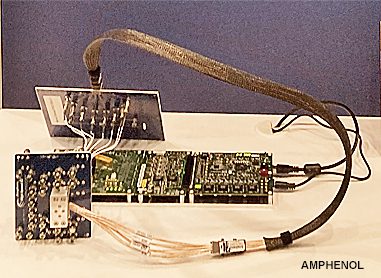
Amphenol Communications Solutions, a live demonstration consisting of a Paladin HD2 right-angle PCB connector mating with a Paladin HD2 pass-through to a one-meter passive cable assembly and Ultra Pass connector to PCB operated at 212 Gb/s PAM4.
It appears that systems running at 224+ Gb/s will require the adoption of cable backplane architecture. Another display included a QSFP-DD 1600 transceiver chip to module application operating at 224G per channel using a Cadence SERDES.
A new ExaMax 2 ARC backplane connector has been designed to support 112 Gb/s PAM4 applications and has been modified to operate immersed in cooling liquids.
Linear optics is a technology that is a work in progress but offers significant advantages in power reduction, latency, and cost. An Amphenol demonstration featured an OSFP800-DR8 linear pluggable transceiver with a Broadcom TH5 MTP.
A display of direct attach, active copper and active optical cable assembles was also featured.
Products displayed in the Molex booth were focused on “Unleashing the Power of 224G” and featured the Inception genderless backplane connector and cable assembly. It is offered in vertical, right-angle, and cable configurations and rated to 224 Gb/s PAM4. Cable assemblies can be designed using 26- or 29-gauge twinaxial cable, currently offered at 85 ohms, with 92 ohms in development.

Release of the Inception family of interconnects provides significant advantages of signal density, performance, and simplicity of implementation.
Molex demonstration boards illustrated the many twinaxial cable-based connectors designed to take high-speed signals out of the PCB and deliver them to the I/O panel.
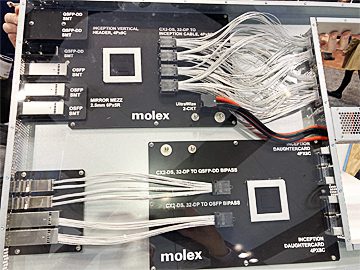 The Mirror Mezz genderless vertical stacking connector family incorporates a series of upgrades to support up to 224Gb signaling. The Mirror Mezz Pro offers improved 112 Gb/s performance while Mirror Mezz Enhanced connectors perform to 224 Gb/s PAM4. MME connectors are targeting GPU to PCB applications.
The Mirror Mezz genderless vertical stacking connector family incorporates a series of upgrades to support up to 224Gb signaling. The Mirror Mezz Pro offers improved 112 Gb/s performance while Mirror Mezz Enhanced connectors perform to 224 Gb/s PAM4. MME connectors are targeting GPU to PCB applications.

The Molex booth also featured a demonstration of a one-meter passive 26-gauge OSFP copper cable assembly running at 224Gb/s PAM4.
Samtec continues to upgrade its flagship high-performance connectors as well as introduce new additions to its extensive product mix.
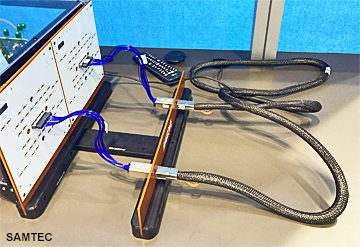
Samtec booth featured multiple live displays, including the new NovaRay I/O connector terminated to two meters of passive #28 cable and operating at 112Gb PAM4.

Cable conductors are terminated directly to the connector contacts, eliminating the associated losses attributed to a traditional paddleboard termination.
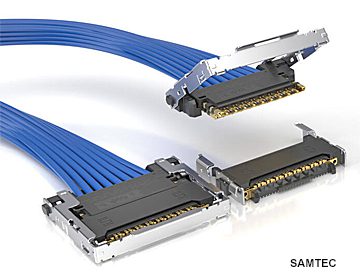
The SI-FLY HD extreme low-profile cable to PCB connector is targeting near-chip PCB to I/O panel connector applications. The 3.8 mm profile, enables extremely close mounting adjacent to an ASIC chip. A live display demonstrated 224 Gb/s PAM4 over 500mm of 34 gauge EYE-Speed Twinaxial cable.
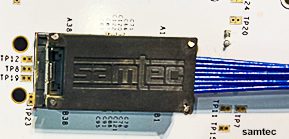
Samtec introduced the next generation HALO optical transceiver, which is designed to perform to 112 Gb PAM4 over eight bidirectional channels.
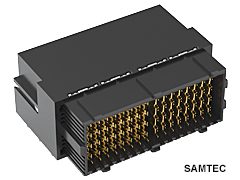
Samtec also showed a new 0.80 mm NovaRay® Micro Rugged Backplane Right-Angle surface mount PCB Header that can provide 112 Gb/s performance in cable backplane applications.
TE Connectivity showcased several new connectors designed to support 112 and 224 Gb/s channels with emphasis on over-the-board interconnects.
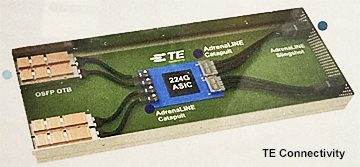
The AdrenaLINE 224 Gb/s connector platform consists of the Slingshot right-angle PCB to cable and cable to cable connector. The Catapult is a high-density, low-profile near-chip connector. Both are rated to 224 Gb/s PAM4 and targeting cable backplane applications. They are currently in pre-release status.
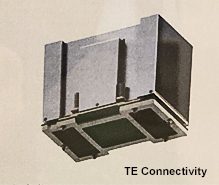
The new SideStack mezzanine connector is a hermaphroditic BGA connector that offers 112 Gb/s PAM4 performance and dedicated power contacts. Multiple stack heights and contact configurations are available in this BGA attached connector.
These connectors are ideal for applications such as GPU to PCB.
Several display boards featured specific product families and how they can provide high-speed over-the-board interconnects that avoid the signal loss and distortion created by conventional PCB trace circuits.

Sliver cable terminated connectors are an example of how systems can be packaged using near-package cable to PCB and direct attach I/O connectors.
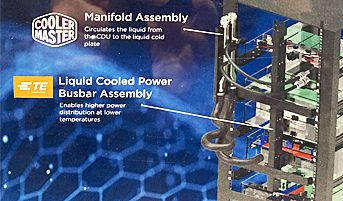
Maintaining a safe operating temperature in data systems racks has become a serious challenge. TE demonstrated a unique liquid cooled bus bar system that creates a circulating cooling liquid jacket around a rear-mounted blind-mate busbar. This “smart” busbar safely allows higher current operating levels.
A series of integrated sensors that monitor voltage, current, and temperature communicate data via RF or the busbar, which trigger alerts that can predict and prevent failures.
A sampling of displays of other connector manufacturers includes:
I-PEX showed its extensive line of extremely low profile cable-to-PCB connectors to support high-performance near-chip applications.
Foxconn Interconnect Technologies (FIT) had a large booth and demonstrated a 224 Gb PAM4 channel over one meter of twinax cable using a Synopsys SERDES. They apparently have tooled the OSFP-XD pluggable optical transceiver.
Luxshare featured an extensive line of small form factor transceivers including 200G / 400G / and 800G in the OSFP envelope. The OmniEdge ultra low-profile connectors feature a 3.9 mm height. The Intrepid high-speed backplane connector family is rated to 112 Gb/s PAM4, with a 212 Gb/s PAM4 version in development.
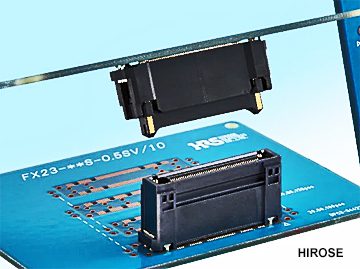
In addition to its incredibly broad line of high-performance mezzanine connectors, Hirose Electric featured its 0.5 mm pitch FX23 backplane floating connector family.
The 2024 edition of DesignCon clearly demonstrated how quickly demands for high-performance, high-density, low latency interconnects are evolving and that copper connectors will continue to be capable of serving many next generation applications.
Bob Hult has attended every DesignCon. See his reviews of DesignCon 2023, DesignCon 2022, DesignCon 2021, and other technology trends.
Like this article? Check out our other Product Roundup, Product News, and Connector Industry News features and our 2023 and 2024 Article Archives Article Archives.
Subscribe to our weekly e-newsletters, follow us on LinkedIn, Twitter, and Facebook, and check out our eBook archives for more applicable, expert-informed connectivity content.
- Optics Outpace Copper at OFC 2024 - April 16, 2024
- Digital Lighting Enhances your Theatrical Experience - March 5, 2024
- DesignCon 2024 in Review - February 13, 2024
